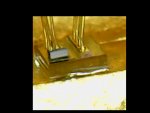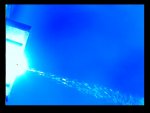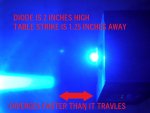brianpe
0
- Joined
- Dec 26, 2012
- Messages
- 56
- Points
- 18
I wanted to see if I could make something with two NUBM44 diodes beam combined and corrected for a better beam profile and decided on a lab format to give me space for optics. I also battery powered it from a large RC car LiPo, so it's portable. I partially succeeded. The NUBM44 is really a horrible diode for beam quality, but if you want photons (and I wanted to see how far I could crank this), it's the easiest ticket in.
Design
The laser uses two NUMB44-81 445nm diodes from DTR. They are focused to infinity with G2 lenses, pass through dual 6x cylindrical lens pairs to tighten the beam, and are combined with a PBS beam cube. One of the lasers has its polarization rotated with a 90 degree wave plate.
Each laser is coupled to an 8A buck driver preset to 5.5A of max current. The drivers have thermistors on the diodes and are microprocessor controlled via PWM so I can control the power from the front panel. The front panel has an LED display to show power output percentage, a latchable fire button knob for power control, and a key interlock.
Here are some shots of the optics and electronics:
Alignment
I aligned the beams and focused as close to infinity as I could using an array of mirrors in my garage / basement: about 100' of total travel. When aligned, the spot size was about 4" over 100', for a divergence of about 3.2mrad.
Finished Result
The final laser outputs over 11 watts of light. I've maxed out my Ophir head (+-12v rails).
Next Project
I'm going to refine this for my next project. I'd like to improve the optics to reduce the divergence and possibly integrate a beam expander in reverse to get a narrower beam and higher power density. I'm also going to rev the electronics and programming -- the minimum PWM today for lasing is 10%, which is over 1W and already class IV. I'm going to halve this by shutting down one diode until I need higher power levels.
I'm also going to improve the display and control electronics. The display is pretty dim and I'd like to show temperature of the diodes and amperage. I'm also going to move away from a simple pot to control PWM power and use a digital rotary encoder. That way I can safely start the lasers at zero every time the device is switched on. I also plan to build the battery into the case and provide integrated charging and support for running off mains. Because why not?
But first, my LPM needs a revision before I can measure any improvements here.
Design
The laser uses two NUMB44-81 445nm diodes from DTR. They are focused to infinity with G2 lenses, pass through dual 6x cylindrical lens pairs to tighten the beam, and are combined with a PBS beam cube. One of the lasers has its polarization rotated with a 90 degree wave plate.
Each laser is coupled to an 8A buck driver preset to 5.5A of max current. The drivers have thermistors on the diodes and are microprocessor controlled via PWM so I can control the power from the front panel. The front panel has an LED display to show power output percentage, a latchable fire button knob for power control, and a key interlock.
Here are some shots of the optics and electronics:
Optics and drivers
The drivers are mounted directly to the 1/4" aluminum base using mica insulators, so this makes...
Alignment
I aligned the beams and focused as close to infinity as I could using an array of mirrors in my garage / basement: about 100' of total travel. When aligned, the spot size was about 4" over 100', for a divergence of about 3.2mrad.
Finished Result
The final laser outputs over 11 watts of light. I've maxed out my Ophir head (+-12v rails).
Over 11 Watts
My LPM is probably topping out here. It's based on an Ophir head powered by +- 12v
Next Project
I'm going to refine this for my next project. I'd like to improve the optics to reduce the divergence and possibly integrate a beam expander in reverse to get a narrower beam and higher power density. I'm also going to rev the electronics and programming -- the minimum PWM today for lasing is 10%, which is over 1W and already class IV. I'm going to halve this by shutting down one diode until I need higher power levels.
I'm also going to improve the display and control electronics. The display is pretty dim and I'd like to show temperature of the diodes and amperage. I'm also going to move away from a simple pot to control PWM power and use a digital rotary encoder. That way I can safely start the lasers at zero every time the device is switched on. I also plan to build the battery into the case and provide integrated charging and support for running off mains. Because why not?
But first, my LPM needs a revision before I can measure any improvements here.


















